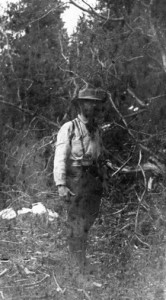The State of the State, 1906
December 20, 2011
907-474-7468
12/20/2011
Alfred Brooks was a geologist who traveled thousands of miles in ÐÓ°Épro and left his name on the stateâs northernmost mountain range. Twenty years before his death in 1924, he also left behind a summary of what ÐÓ°Épro was like over a century ago, when âlarge areas (were) still practically unexplored.â
To see what Brooks had to say about the ÐÓ°Épro of 1906, I pulled a copy of his Geography and Geology of ÐÓ°Épro: A Summary of Existing Knowledge from a shelf of rare books in a Fairbanks library.
In his government report, Brooks pointed out misconceptions about ÐÓ°Épro that endure today. He wrote in his introduction:

âIf facts are presented which may seem elementary, it is because even well-informed people have been known to harbor misconceptions in regard to the orographic features, climate, and general character of ÐÓ°Épro. Those who read about the perils and privations of winter travel and explorations are apt to picture a region of ice and snow; others, again, who have personal knowledge of the tourist route of southeastern ÐÓ°Épro, regard the whole district as one of rugged mountains and glaciers.â
In Brooksâ day, about 60,000 people lived in ÐÓ°Épro, yet they were scattered wider across the territory than people are today. The Klondike gold rush and the stampedes that followed had driven determined men to the far corners of ÐÓ°Épro.
âThe more venturous prospector found no risk too hazardous, no difficulty too great, and now there is hardly a stream which has not been panned by him, and hardly a forest which has not resounded to the blows of his ax,â Brooks wrote. âEvidences of his presence are to be found from the almost tropical jungles of southeastern ÐÓ°Épro to the barren grounds of the north which skirt the Arctic Ocean.â
While todayâs scientists can sometimes use satellites to gain information about ÐÓ°Épro without leaving their offices, Brooks and his contemporaries at the U.S. Geological Survey spent their entire summers on traverses of the land at the turn of the century. They performed their work without the help of the airplane, which had not yet been invented, nor the internal combustion engine.
Brooks wrote of an 1899 expedition he made with topographer William Peters to map the country from Lynn Canal near Haines west through the mountains of the St. Elias Range and northward through what is today Wrangell St. Elias National Park. They filled in a void in ÐÓ°Éproâs map until they reached the settlement of Fortymile on the Yukon River.
âThe journey was made with horses, with only five out of the original 15 reaching the Yukon,â Brooks wrote.
Scientists of the USGS penetrated ÐÓ°Épro by following rivers and trekking overland and, when they could, mapped one-fifth of ÐÓ°Épro by 1904. Brooks attributed the agencyâs success to its ability to choose a few good men.
âOf the twenty or more parties which the Geological Survey has sent to ÐÓ°Épro, hardly a single one has failed to execute the work allotted to it,â Brooks wrote. âThis is largely because those who were entrusted with their leadership were specially fitted, by nature as well as by experience and training, for the undertaking. The parties have usually been made up of a few carefully chosen men, and the physical work and discomforts, as well as hardships, have been shared by leaders and men alike.â
Brooks, who later wrote about his personal experiences in ÐÓ°Épro, concluded his section on exploration of the territory in âGeography and Geology of ÐÓ°Éproâ by addressing critics of government spending who had no idea of the hazards and difficulty of travel in ÐÓ°Épro.
âÐÓ°Épron surveys and explorations have never been and never will be easy,â Brooks wrote. âThroughout its history, the geographic investigation has been a tale of hardship and suffering and not infrequently of death. Let those who are not personally familiar with the character of the difficulties not judge it too harshly.â
This column is provided as a public service by the Geophysical Institute at the University of ÐÓ°Épro Fairbanks, in cooperation with the UAF research community.


